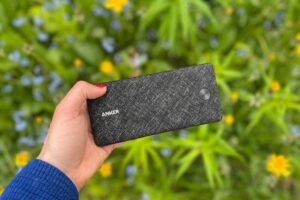If you spend a lot of time outside, regardless of whether you live in a sunny climate or not, you know the importance of a quality pair of sunglasses to protect your eyes from UV light and prevent eye strain. Polarized sunglasses take this a step further by reducing glare from flat surfaces like water and snow, making them a critical piece of gear skiing, mountaineering, packrafting, canoeing, and other adventures. They’re also a great everyday option for driving.
With so many different sunglasses on the market, it can be difficult to know which pair to choose. To help you pick, we tested dozens of sunglasses all over the country, from skiing in the Cascades to rock climbing in the Southwest. We’ve run at 14,000ft, where the sun’s rays are more intense, and we’ve swam, fished, and paddle-boarded on lakes and rivers where polarized lenses help cut the glare from the water’s reflective surface. The sunglasses we chose for this guide are made for a variety of different purposes, from everyday wear to running, biking, and skiing. We also chose polarized sunglasses in a range of different shapes and materials.
Editor’s Note: We updated this guide on May 15, 2024, to announce the Roka Rory 2.0 Sunglasses as our Best Overall Polarized Sunglasses, and the Goodr OGs Polarized Sunglasses as our Best Budget Polarized Sunglasses. We also added superlatives for Most Protective Polarized Sunglasses and Best Polarized Sunglasses for Biking and Skiing.
Our Picks for the Best Polarized Sunglasses of 2024
- Best Overall Polarized Sunglasses: Roka Rory 2.0 Sunglasses
- Best Polarized Sunglasses Runner-Up: Bajio Cometa Polarized Sunglasses
- Best Everyday Polarized Sunglasses: Ray-Ban Original Wayfarer Polarized Sunglasses
- Best Polarized Aviator Sunglasses: Ray-Ban Aviator Classic Polarized Sunglasses
- Most Protective Polarized Sunglasses: Wiley X Founder Polarized Sunglasses
- Best Sunglasses for Biking and Skiing: Smith&subId2=explorersweb Wildcat Sunglasses
- Best Budget Polarized Sunglasses: Goodr OGs Polarized Sunglasses
Best Overall Polarized Sunglasses:
Roka Rory 2.0 Sunglasses
Features: 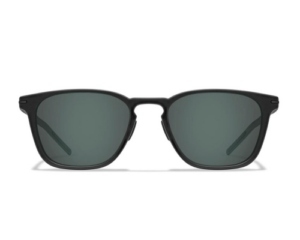
- Durable, lightweight, and flexible with high-impact strength
- Chemical and sweat-resistant
- GEKO Pads™ on the temples and nose for extra traction
- 1,000-day warranty
- Scratch resistant
- Hydrophilic properties – tackier when wet or sweaty
Why we like them: Incredibly lightweight, stay in place while running and jumping, sweat resistant
What we don’t like: Expensive, don’t offer the most coverage
Frame material: Nylon | Lens material: Polycarbonate | VLT: 9 to 17%
Chelsey has been using the Roka Rory 2.0 Sunglasses ($220) as her daily-wear polarized sunglasses for years. When she finally stepped on and snapped the arm of her original pair, she tried a few other sunglasses before going right back to the Rokas. She loves how lightweight they are, and that they don’t bounce on her face while running. The frames are also low enough profile to fit easily under the brim of a baseball cap or a helmet.
The Roka Rory’s have several lenses to choose from, with a range of VLT percentages. The lenses themselves are startlingly clear, and offer a crisp view with a wide field of vision. They’re fog-resistant, making them a great choice for sweaty adventures.
Best Polarized Sunglasses Runner-Up:
Bajio Cometa Sunglasses
Features:
- Blocks 95% of bad blue light
- LAPIS™ lens technology
- Ergo, non-slip rubber nose pads
- Comfortable barrel hinges
- Glare-blocking frames
- Carbon neutral company
Why we like them: Excellent color-enhancing protection, scratch-resistant lenses
What we don’t like: Expensive, thick frames
Frame material: Nylon | Lens material: Polycarbonate or glass | VLT: N/A
The Bajio Cometa Sunglasses ($209), which are specifically designed for long days on the water, are a stylish and functional addition to anyone’s sunglass arsenal. They feature high-quality frames in a few different colors, and you can choose between polycarbonate and glass lenses, as well as a variety of tints. Ilana has the pink gloss frame and blue mirror lens combination, and they’re great for everyday use, as well as fishing, paddleboarding, and river trips. Ilana also wore them to protect her sensitive eyes after she suffered a major concussion, and liked how much of the sun’s glare they blocked. A built-in sun ledge on the interior offers even more protection.
The frame is made of bio-based nylon and is sturdy, lightweight, and sits comfortably on your face. We also love the rubber nose pads, five-barrel hinges, and hidden rubber temple tips.
Best Everyday Polarized Glasses:
Ray-Ban Original Wayfarer Polarized Sunglasses
Features:
 Polarized and coated with 100% UV protection
Polarized and coated with 100% UV protection- Unisex acetate frame
- Different frame sizes available
- Crystal Lens
- Case and lens cloth included
Why we like them: High quality and comfortable, classic design
What we don’t like: Frames feel heavy and can bounce when running
Frame material: Acetate | Lens material: Glass | VLT: 15%
Ray-Ban Wayfarers ($180) are classically shaped sunglasses that look good on just about anyone. Multiple-sized frames allow you to pick the one that best fits you, and there are also plenty of lens options. The legendary Ray-Ban polarized lenses provide complete UV protection while reducing glare and eye strain, and improving contrast and clarity. The crystal lenses are scratch-resistant and extremely durable.
The Ray-Ban Wayfarers, with their classic look and high-quality lenses, are a great option for everyday sunglasses.
Best Polarized Aviator Sunglasses:
Ray-Ban Aviator Classic Polarized Sunglasses
Features: 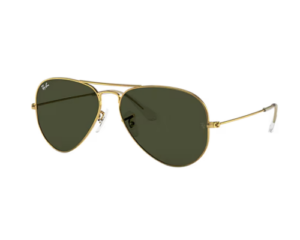
- Adjustable nose pads
- One of the most iconic sunglass models in the world
- Available in prescription lenses
- Available in multiple sizes
Why we like them: Incredibly lightweight, sweat-resistant
What we don’t like: Expensive, may not be suitable for running and high-impact sports
Frame material: Metal | Lens material: Glass | VLT: N/A
Propelled back to popularity in the 1980s thanks to the movie Top Gun, Ray-Ban Aviators ($180) are arguably the world’s most iconic sunglasses. Originally designed for pilots back in 1938, they’ve stood the test of time and have retained their popularity thanks to their classic look and crystal-clear lenses. The thin metal frame with the instantly recognizable inverted teardrop lens has spawned a host of imitators — none of which live up to the quality and style of the original.
With plenty of different sizes, lenses, and frame colors to choose from, this is a design that suits just about any face shape. The polarized glass lenses improve clarity and contrast while reducing glare and providing UV protection.
Most Protective Sunglasses:
Wiley X Founder Polarized Sunglasses
Features: 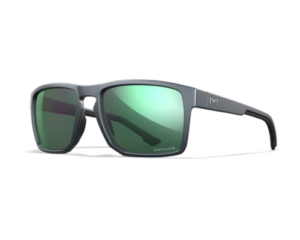
- 100% protection from UVA and UVB with distortion-free clarity
- ANSI Z87.1 safety standards rated
- Lightweight frame
- Removable side shields
Why we like them: Safety glasses rated, full coverage
What we don’t like: Expensive, may feel large on smaller faces
Frame material: Nylon | Len material: Polycarbonate | VLT: N/A
Wiley X is a family-owned and veteran-founded company dedicated to creating protective, tactical eyewear that also looks good. The Wiley X Founder Sunglasses ($206) are Chelsey’s favorite full-coverage sunglasses. The frames are lightweight with a sleek look and dual-injected rubber temples for a no-slip fit.
Wiley X’s entire range of eyewear meets or exceeds industry standards for safety and optics and the Founders have ANSI Z87.1-rated frames, so they can double as safety glasses. Their full-coverage lenses and the removable side shields for the frames also make these sunglasses an ideal choice for high-speed activities such as cycling, skiing, and snowboarding. The polarized lenses can be swapped for custom prescription lenses as well.
Best Sunglasses for Biking and Skiing:
Smith Wildcat Sunglasses
Features: 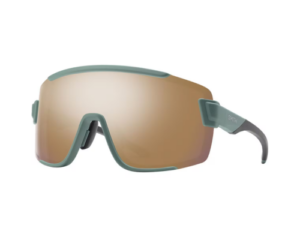
- Performance sunglasses made for cycling, running, and biking
- Hydroleophobic coating resists water, oil, and smudges
- Temple and nose pads are designed for a secure fit when sweating
- Bonus, interchangeable clear lens for cloudy days
Why we like them: Full coverage frame inspired by ski goggles, secure fit that doesn’t bounce
What we don’t like: Expensive, frames can be tricky to swap in and out
Frame material: Bio-based plastic | Len material: Polycarbonate | VLT: N/A
The Smith Wildcat Sunglasses ($225) are Chelsey’s favorite glasses for mountain biking, trail running, and backcountry skiing. The full-coverage lens has a slight wrap-around fit, which protects her eyes and keeps them from watering at higher speeds. The ChromoPop™ lens also enhances natural colors for sunny days and there’s a bonus clear lens for cloudy days when you want eye protection without a tint. With grippy nose pads and temples, these polarized frames won’t slip when bounced around or when you’re sweaty.
Smith also offers the Bobcat Sunglasses, which are made for smaller faces.
Best Budget Polarized Sunglasses:
Goodr OGs Polarized Sunglasses
Features: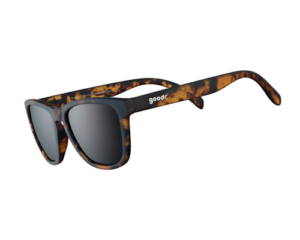
- Glare-reducing lenses that block 100% of harmful UVA and UVB rays
- Classic frame shape with timeless appeal
- Lightweight with a comfortable, no-bounce fit
- Grip-coated frame to prevent slippage when sweating
- Biodegradable, organic lenses
- Climate Neutral Certified brand
Why we like them: Inexpensive, comfortable, and relatively high-performing
What we don’t like: Lenses don’t have the same clarity as more expensive glasses
Frame material: Copolyester | Lens material: Triacetate cellulose | VLT: N/A
The Goodr OGs Polarized Sunglasses ($25) are less than a quarter of the price of other sunglasses on this list. They’re still surprisingly high-performing, making them our pick for the best budget polarized sunglasses. Goodr OGs have a classic, lightweight square frame that comes in a variety of colors. The lenses are non-reflective, which reduces glare, and have a scratch-resistant and shatterproof layer. Compared to more expensive sunglasses, the cellulose lenses lack a little clarity and crispness, but that’s to be expected at such a low price. Chelsey keeps a pair of Goodrs in her truck and uses them for packrafting, bushwhacking, and other outdoor adventures where she’s likely to lose or scratch her glasses. Since a pair of Goodrs only costs her $25, she can beat them up guilt-free.
Honorable mentions
Sunski Dipsea Polarized Sunglasses
Features:
- Recycled, superlight polycarbonate frame

- 100% UV-protected lens
- Interchangeable lenses
- Lifetime warranty
The Sunski Dipsea Polarized Sunglasses ($58) have been Ilana’s go-to sunglasses for years. They are an affordable option that doesn’t sacrifice quality. They have interchangeable lens options, and, if you scratch or damage the lenses, you can buy new ones without having to purchase a new pair of sunglasses.
Sunski created their own lightweight, recycled material for their frames. The frames also come with a Lifetime Warranty, which includes getting eaten by your dog or dropped off a cliff — they’re designed for adventure and the lifestyle you live. Read Ilana’s in-depth review of the Sunski Dipseas here.
About our testing process
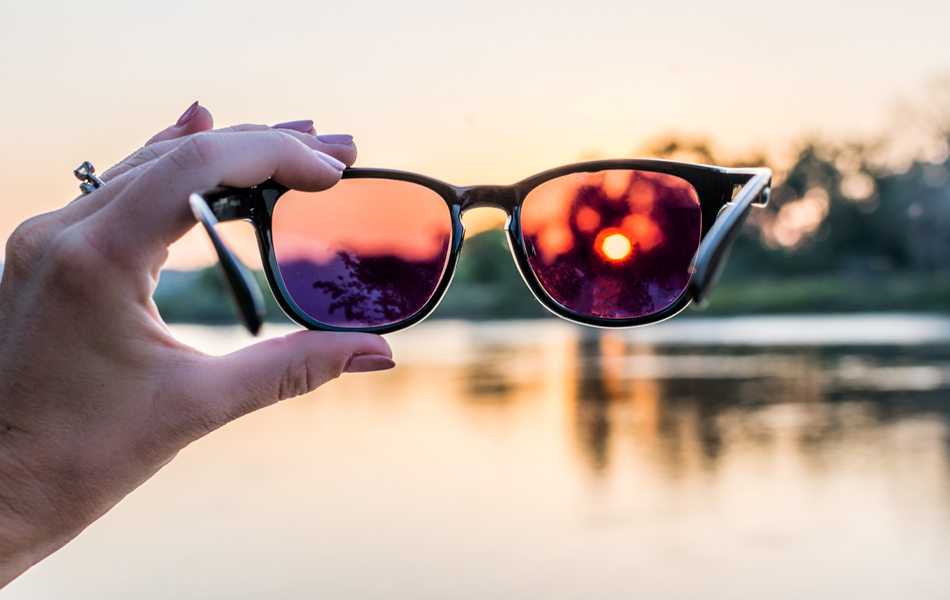
The ExplorersWeb team has tested dozens of polarized sunglasses all across the country, from skiing in the Cascades to rock climbing in the Southwest to packrafting in Alaska. We’ve tested them at high altitudes, where the sun’s rays are more intense, and we’ve swam, fished, and paddle-boarded on lakes and rivers where polarized lenses help cut the glare from the water’s reflective surface.
Ilana Newman started this guide in 2022. She lives in southwest Colorado, where the sun shines more days than not. A good pair of polarized sunglasses is a must for outdoor adventures there, and Ilana takes her eye protection seriously, whether she’s climbing in the red rock deserts or skiing in the San Juans. She’s known for being rough on her gear and prioritizes durable sunglasses that will last more than one season.
Gear Editor Chelsey Cook took over the guide in May 2024. She’s a mountain guide in Alaska and spends most of the year on the snow or the water, and relies on sunglasses to keep her eyes safe. She also has very sensitive eyes and is rarely without sunglasses even in her daily life. Because she wears them so often, she needs comfortable, lightweight sunglasses that offer maximum protection and don’t bounce on her face when she’s running or biking. She tried most of the sunglasses in this guide, and the top picks represent her favorites after years of testing them while hiking, trail running, biking, skiing, and mountaineering.
We chose the sunglasses on this list after extensive research and testing. When testing sunglasses for comfort, we wore the sunglasses for hours at a time and assessed for any headaches or discomfort afterward. We also ran and biked in the sunglasses to make sure they didn’t bounce on our faces, and checked the lenses after bushwhacking in them to make sure they didn’t scratch easily.
Our guide includes polarized sunglasses for both casual wear and performance sports, in a range of frame shapes and sizes.
Features to look for in polarized sunglasses

Shape and design
Frame shape and design dictate the aesthetics of a pair of sunglasses, and depending on your preference, you may want square frames or round. Shape and design also have an impact on performance. Wide, large lenses provide more protection from the sun and are ideal for snow and water adventures, where the sun’s rays can be more intense. Wraparound frames, or frames with side shields like the Wiley X Founder Polarized Sunglasses, which are also safety-rated, offer the most protection.
Frame material
Frame material affects the appearance and weight of sunglasses. The majority of polarized sunglasses we tested are made from different plastics, including nylon and polyester. Plastic is lightweight and durable, making it a great material for sunglasses for running, hiking, and biking. Some sunglasses are also made of plant-based plastics, like cellulose acetate, which is more sustainable, hypoallergenic, strong, lightweight, and flexible. Metal, used in the Ray-Ban Aviator Polarized Sunglasses, is a durable frame material but can be more expensive.
Lens material
Sunglass lenses come in a few different materials, and each one differs in their performance and clarity. Acrylic is the most affordable but, while lightweight, is less durable and has less optical clarity. Polycarbonate, which is used in the Smith Wildcat Sunglass lenses, is affordable and lightweight with good impact resistance and clarity but is less scratch-resistant than other options. Lastly, glass has the most clarity but is the most expensive. It’s also heavier than other options and can “spider” when cracked, like a windshield.
Visible light transmission (VLT)
Sunglass lenses generally have a specification known as VLT, or visible light transmission. This is the percentage of light that reaches your eyes through the lens. The smaller the percentage, the less light is transmitted through the lens. If you have sensitive eyes or will be using your sunglasses while on snow or water, look for sunglasses with a low VLT percentage. Glacier glasses, which are designed to offer the maximum protection for your eyes, have a VLT between 5 and 7%. While great for those specific conditions, they are typically too dark for daily wear. A VLT of 10 to 25% is a good choice for general outdoor use.
Price
Sunglasses come in a range of prices, from $25 to over $200. Cheaper sunglasses generally lack the lens clarity and high-quality frames of more expensive choices but are a great option if you don’t use sunglasses often, or have a tendency to lose or break them. More expensive sunglasses generally have crystal-clear lenses that don’t distort your vision. They also may have features like rubber grips to prevent slipping, adjustable nose pads, and interchangeable lenses. If you wear sunglasses daily or have very sensitive eyes, you may want to opt for a pricier, higher-performing pair.
Frequently asked questions about polarized sunglasses
How do polarized lenses work?
Polarized lenses absorb reflected light, such as the light that bounces off of water, snow, or any other highly reflective surface. They only allow light in from one direction and reduce glare by blocking all horizontal light, like the light that bounces off of smooth water or shiny surfaces.
How can I tell if lenses are polarized?
There’s an easy trick to tell if your new lenses are polarized or not. Find a reflective surface, such as water, metal, or glass, and hold the glasses away from your face slightly. Tilt the glasses 60 to 90 degrees. If the lenses shift to black, then they are polarized. You should also notice a difference when looking at an LCD screen with polarized glasses.
Does the polarized coating on sunglasses wear off?
The polarization does not wear off unless the lenses chip or crack. However, the protective coating that blocks UV rays can gradually wear off.
Are there any downsides to polarized lenses?
Polarized sunglasses are not for everyone nor are they for every situation. They can distort your vision by showing unusual patterns in certain conditions. They can also make it difficult to differentiate ice from snow, and some skiers may prefer non-polarized lenses. Polarized lenses are also not the best for looking at screens, as the light filtering process can make the screen disappear from view at certain angles.
Is 100% UV protection the same as polarized?
No. Your sunglasses can be 100% UV protected and not be polarized, and vice versa. Polarization is not the same as UV protection, however many polarized lenses now also have a UV-blocking feature.

